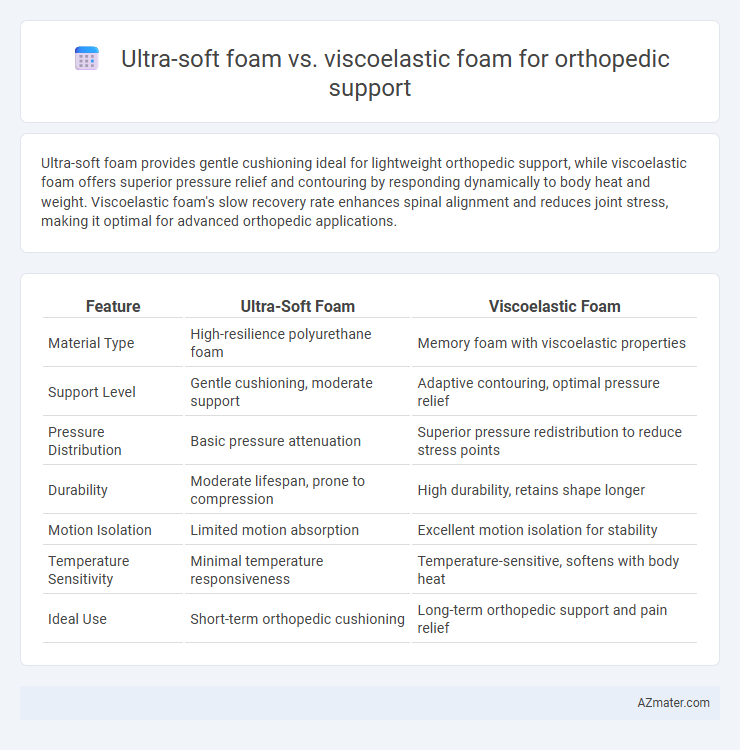Ultra-soft foam provides gentle cushioning ideal for lightweight orthopedic support, while viscoelastic foam offers superior pressure relief and contouring by responding dynamically to body heat and weight. Viscoelastic foam's slow recovery rate enhances spinal alignment and reduces joint stress, making it optimal for advanced orthopedic applications.
Table of Comparison
| Feature | Ultra-Soft Foam | Viscoelastic Foam |
|---|---|---|
| Material Type | High-resilience polyurethane foam | Memory foam with viscoelastic properties |
| Support Level | Gentle cushioning, moderate support | Adaptive contouring, optimal pressure relief |
| Pressure Distribution | Basic pressure attenuation | Superior pressure redistribution to reduce stress points |
| Durability | Moderate lifespan, prone to compression | High durability, retains shape longer |
| Motion Isolation | Limited motion absorption | Excellent motion isolation for stability |
| Temperature Sensitivity | Minimal temperature responsiveness | Temperature-sensitive, softens with body heat |
| Ideal Use | Short-term orthopedic cushioning | Long-term orthopedic support and pain relief |
Introduction to Orthopedic Support Materials
Orthopedic support materials commonly include ultra-soft foam and viscoelastic foam, each offering unique benefits for spinal alignment and pressure relief. Ultra-soft foam provides gentle cushioning suitable for lightweight support, while viscoelastic foam, also known as memory foam, contours precisely to the body's shape, enhancing joint stability and reducing stress points. These materials are integral in orthopedic mattresses and cushions designed to alleviate discomfort and promote proper posture.
What Is Ultra-Soft Foam?
Ultra-soft foam is a highly pliable cushioning material designed to provide gentle support and exceptional comfort by conforming closely to the body's contours, significantly reducing pressure points. This foam type is often used in orthopedic support for its ability to enhance pain relief and improve sleep quality through superior contouring and shock absorption. Compared to viscoelastic foam, ultra-soft foam offers a lighter, more breathable option that maintains durability while delivering maximum softness and flexibility.
Understanding Viscoelastic (Memory) Foam
Viscoelastic foam, commonly known as memory foam, offers superior orthopedic support by conforming precisely to body contours and distributing weight evenly to alleviate pressure points. Unlike ultra-soft foam, viscoelastic foam possesses viscoelastic properties that slow its response to pressure, enabling enhanced spinal alignment and muscle relaxation. Its density typically ranges from 3 to 5 pounds per cubic foot, providing durable support ideal for therapeutic applications in mattresses and cushions.
Key Differences: Ultra-Soft vs Viscoelastic Foam
Ultra-soft foam offers a gentle cushioning effect with high initial softness, ideal for light pressure relief and enhanced comfort. Viscoelastic foam, commonly known as memory foam, provides superior orthopedic support by contouring closely to the body's shape, distributing weight evenly and reducing pressure points. Key differences include ultra-soft foam's quicker responsiveness and softness versus viscoelastic foam's slow recovery time and superior body-conforming properties, making each suited for distinct orthopedic needs.
Pressure Relief Capabilities Compared
Viscoelastic foam offers superior pressure relief capabilities compared to ultra-soft foam due to its ability to conform closely to body contours and evenly distribute weight, reducing stress on pressure points. Ultra-soft foam provides comfort but lacks the adaptive response necessary to alleviate concentrated pressure areas effectively. For optimal orthopedic support, viscoelastic foam's viscoelastic properties enhance spinal alignment and minimize discomfort in prolonged use.
Spinal Alignment and Support Effectiveness
Ultra-soft foam offers gentle cushioning that enhances comfort but may lack sufficient firmness for effective spinal alignment, potentially leading to inadequate orthopedic support over time. Viscoelastic foam, known as memory foam, adapts to body contours by distributing weight evenly, promoting precise spinal alignment and reducing pressure points crucial for orthopedic health. Clinically, viscoelastic foam demonstrates superior support effectiveness by maintaining natural spinal curves and minimizing misalignment risks compared to ultra-soft foam options.
Durability and Longevity of Both Foams
Ultra-soft foam offers moderate durability with a tendency to compress and lose shape over time, making it less ideal for long-term orthopedic support. Viscoelastic foam, also known as memory foam, provides superior longevity due to its high density and ability to retain shape after repeated use, ensuring consistent orthopedic support. The viscoelastic foam's durability significantly reduces the need for frequent replacement compared to ultra-soft foam, making it a better investment for sustained comfort and joint relief.
Breathability and Temperature Regulation
Ultra-soft foam offers moderate breathability with open-cell structures that allow airflow, helping maintain cooler surface temperatures during use. Viscoelastic foam, or memory foam, typically exhibits lower breathability due to its dense composition, which can trap heat and reduce temperature regulation efficiency. Advanced viscoelastic foams with gel infusions or convoluted designs improve ventilation and thermal dispersion, enhancing orthopedic support comfort.
Ideal Users and Medical Recommendations
Ultra-soft foam provides gentle cushioning ideal for individuals seeking comfort with mild orthopedic needs, such as those with sensitive skin or light pressure points, while viscoelastic foam, also known as memory foam, offers superior contouring and support recommended for patients with chronic back pain, arthritis, or post-surgery recovery. Medical experts suggest viscoelastic foam mattresses and cushions for enhanced spinal alignment and pressure relief, benefiting users requiring consistent orthopedic support. Ideal users of ultra-soft foam prioritize softness over structural support, whereas viscoelastic foam is favored for therapeutic use and long-term musculoskeletal health.
Conclusion: Choosing the Right Foam for Orthopedic Support
Ultra-soft foam provides gentle cushioning ideal for those needing mild support and enhanced comfort, while viscoelastic foam, also known as memory foam, offers superior orthopedic benefits by contouring closely to the body and distributing pressure evenly. For effective pain relief and spinal alignment, viscoelastic foam is often preferred due to its durability and ability to reduce stress on joints and muscles. Selecting the right foam depends on individual orthopedic needs, with viscoelastic foam favored for targeted support and ultra-soft foam suited for comfort-focused applications.

Infographic: Ultra-soft foam vs Viscoelastic foam for Orthopedic support
 azmater.com
azmater.com